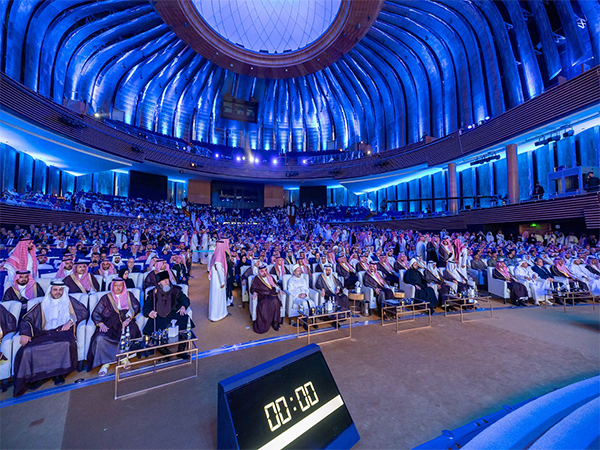Assam: Human elephant conflict-affected women play key role in Aaranyak-SBI foundation's mitigation efforts
Mar 08, 2024

Guwahati (Assam) [India], March 8 : Women from the local communities in Assam have been extending cooperation towards environmental organisation Aaranyak's efforts supported by the SBI Foundation (SBIF) in the mitigation of human-elephant conflict.
Aaranyak has been on an overdrive to elicit cooperation from the community towards the Human Elephant Conflict (HEC) mitigation efforts in various hotspots spread over Udalguri, Baksa and Tamulpur districts of Assam.
The women from the community have been in focus of the efforts in respect of economic empowerment through providing livelihood options, skilling them in administering first-aid in HEC-induced emergency situations besides securing their life and livelihood through various HEC mitigation tools including solar-powered fences.
The womenfolk of various HEC-affected villages in these two districts who used to have umpteen sleepless nights out of fear of wild elephants, can now not only sleep in peace at night but also carry on with their daily chores and income-generating activities sans any fear in the wake installation solar-powered fences to protect their homes and crop field.
These women have now formed a key part of Aaranyaks' efforts for HEC mitigation based on community participation at ground zero.
One such woman, Rita Boro (53 years old) who hails from Segunbari village of Udalguri District, had participated as a community volunteer in a First Aid training programme held at IIBM Guwahati on April last year with support from SBI Foundation.
The programme was conducted with the aim to equip people with essential skills and knowledge to aid during encounters with elephants and in any emergencies requiring basic pre-hospital treatment.
Since then, she has often been involved with Aaranyak in conducting such training in her locality.
Rita, who also serves as a mid-day meal cook for a school, actively contributes to the community through social assistance and engages herself in different farm and non-farm-based activities within an SHG.
After completing her First-Aid training, Rita had the opportunity to apply her skills in a real-life situation as shared by herself - "On April 17, 2023, while returning home after attending a training organised by JJM in Bamunjuli, I happened to encounter with Pangru Baraik, a man who was sitting on the road. His left leg was severely wounded from the toe to the patella after feeling an areca nut tree. Noticing him in pain, I immediately got down from my scooty and asked the villagers for assistance. Unfortunately, no one came forward to help. Luckily, an elderly villager from Segunbari was passing by and offered his cloth, which I used to wrap the injured area to stop the bleeding. I also contacted Dibakar Nayak, a fellow of the Aaranyak team, to assist in taking the injured to the hospital and then we called for an ambulance. After a 40-minute wait, the ambulance arrived and took the patient to the hospital."
She highlighted the significance of first-aid training for village residents, as numerous such incidents often occur in these communities.
She expressed her deep appreciation for having undergone this training, which proved invaluable when she needed to manage a wounded person. Rita remains dedicated to using the skills to assist others in need thereby enhancing the well-being of her community.
In the face of persistent challenges from wild elephants, eighteen brave women of four self-help groups from Badlapara village in Udalguri district embraced a transformative venture of cultivating alternative crops like taro, turmeric, and black lentils which are not foraged by elephants.
This group of women are from landless families who would cultivate on lands abandoned by owners due to wildlife depredations. Sometimes they would take on lease such land.
With unwavering determination, they cultivated 150 kilograms of turmeric rhizomes, supported by Aaranyak and SBI Foundation, in a one-bigha plot during April last year.
Despite multiple trampling by elephants, the turmeric plants displayed resilience. Also recognizing the threat from cattle, these women pooled their resources to purchase five bundles of wire fencing worth Rs 4,750 to encircle their plot. This collective effort has successfully safeguarded their cultivation plot from livestock intrusion; demonstrating the power of community collaboration in overcoming challenges.
Currently, a portion of the cultivation has been harvested yielding 250 kilograms of produce. The women, though deterred by adversities and instead of selling it raw, decided to go for value addition and sell it as a powder to net a better profit. They took a strategic step to cut manpower costs by distributing the harvested turmeric among themselves in equal quantities for boiling and sun-drying which will then be collected back for further processing into turmeric powder.
The success story of these women in Badlapara is a beacon of hope and inspiration. The resilient alternative crop venture also still has confidence in the community, showcasing the transformative potential of sustainable agriculture in the face of elephant depredation.
Anaithi Boro, a resident of Salguri village in Udalguri district is a single mother, who used to bear the brunt of HEC in the form of crop damage. In order to supplement her subsistence livelihood, Aaranyak has extended support, sensitised her and encouraged the cultivation of crops that are less palatable to elephants.
Anaitha said - "I have sown 3.75 kg of mustard seeds with support from Aaranyak-SBIF in two bighas (equivalent to 0.50 hectares) of land, and spent Rs.1600 for ploughing the field with a tractor. After around 2.5 months, when I saw my field turn yellow with mustard flowers, I was very happy. I could harvest around two quintals of the yield and sell it in the market. I am happy that my crops were not damaged by elephants."
These are just a few examples reflecting how HEC mitigation efforts by Aaranyak in collaboration with SBIF, have secured the life and livelihood of people especially the village womenfolk who always stand vulnerable to the HEC.



















